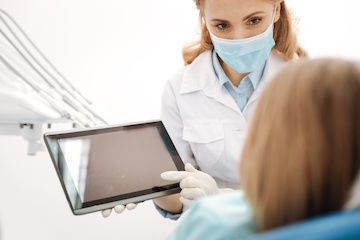Millennial Dentists are Blazing New Pathways
Millennial dentists are growing up quickly and changing the face of the industry. With a focus on technology and patient experiences, they've issued a challenge to older more established dentists: Adapt, or get left behind.

Millennial dentists are especially good at incorporating technology into their practices.
There are some new kids on the block, and they truly are a hit in their field, though they’re hardly kids.
They’re the next generation of dentists — millennials who have graduated dental school over the last 10 years or so, and they’ve been successful not just buying into practices, but building large, successful practices much faster than their predecessors.
“Building strong, cohesive teams is really the key to practice success,” says Dan Croft, head of healthcare practice solutions at TD Bank. “It’s their team-oriented approach and the embrace of technology that’s the biggest difference between them and the baby boomers.”
SECOND NATURE
Ken Rubin, C.P.A., P.F.S., principal of Ken Rubin & Company Dental CPAs, says there’s a parallel between older dentists and businesses like his CPA firm, which he’s been running for 32 years. That parallel is the importance of reinventing oneself.
“We used to get clients by being in the Rotary Club, and the Kiwanis, and doing external marketing with postcards, discount coupons and the Yellow Pages,” Rubin explains. “That’s all changed with the Internet.”
And millennials, who have grown up in today’s technology world, know how to leverage that technology to capture a sizeable market share in a relatively short amount of time. They’re comfortable with technology, and it’s not limited to social media. They’re also investing in the latest technology for their practice, which — despite leaving dental school with significant loans—is enabling them to do more procedures, and do them faster.
“Patients don’t have to come in twice,” Rubin says. “They can come in one day and get same-day crowns. They don’t have to take off of work, fight traffic, sit in the lobby, get numbed up, and do that twice. And that’s very appealing in today’s busy world.”
Croft says these millennial dentists are also much more focused on the importance of the patient experience. That has enabled them to foster greater connections with patients by giving them increased access to healthcare, as well as access to the dentist via email or text.
“Making yourself available is unusual for most doctors, right?” Croft asks, rhetorically. “I think this generation appears to have taken a step back. They accept feedback, and they make changes to their practice.”
BUYING, NOT LEASING
Rubin says another distinguishing factor among millennial dentists is they are purchasing the physical location of their practice rather than leasing for 30 years and making someone else rich. In that respect, they’re well positioned with an asset they can sell when they retire.
“The number one investment you can make is in yourself, and your education,” Rubin says. “We’re seeing more young dentists who want to own their location than ever before in southern California.”
And banks, Croft agrees, are much more comfortable lending for tangible assets like cars, buildings and equipment. That’s because the collateral is a tangible asset. The doctor owns the practice and the building. He or she has control, and eliminates any issues that could arise when negotiating a new lease or having to relocate if a new owner decides to increase the rent.
“When you put it all together, and you have the down payment available, generally you’re going to have a decrease in the monthly payments,” Croft says. “So, from a bank’s perspective, as time goes on you’ve got more equity in your practice, you’re paying down your loan, and the practice hopefully is increasing in value. You’re basically creating a valuable asset.”
FUTURE OUTLOOK
Croft says that the direction millennial dentists are taking their practices is good for the industry, and he expects the trend to continue—especially since many patients are millennials as well.
“They want instant gratification,” Croft says. “They want accessibility, they want the bet technology, and they want the best communication. So the millennials in general will definitely have a powerful impact on the future design of dental practices, and the services offered.”
Rubin poses a rhetorical question: Is it a good time to be a dentist? He thinks it is, providing you’re taking the proper steps to compete.
The younger dentists, he says, are doing just that. They’re bringing in 50 to 100 new patients every month only six months after opening their practice. And older dentists who don’t adapt — who don’t run their business like a business, encourage online reviews from patients or manage their online reputation—are getting left behind.
“It’s a phenomenal time to be a dentist,” Rubin says. “But you have to be doing everything, or enough things, right.”
ACTIVA BioACTIVE Bulk Flow Marks Pulpdent’s First Major Product Release in 4 Years
December 12th 2024Next-generation bulk-fill dental restorative raises the standard of care for bulk-fill procedures by providing natural remineralization support, while also overcoming current bulk-fill limitations.